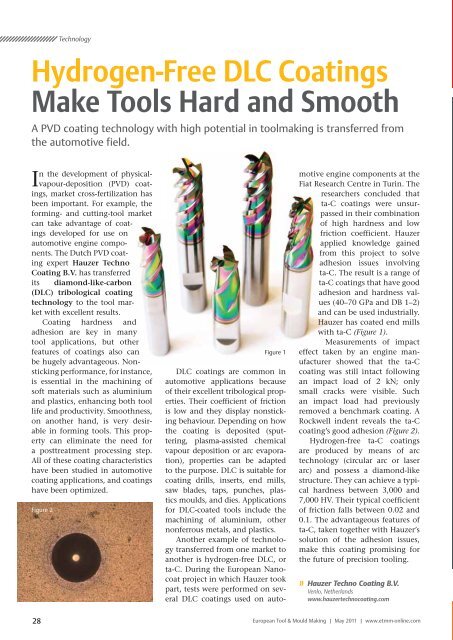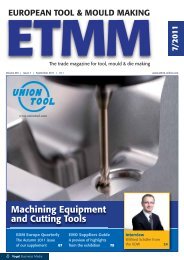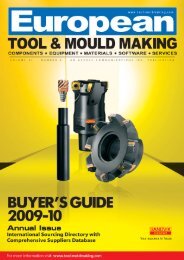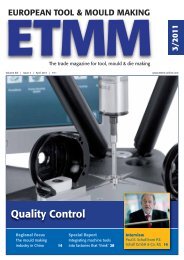Hot Runners and Mould Components - ETMM-Online
Hot Runners and Mould Components - ETMM-Online
Hot Runners and Mould Components - ETMM-Online
Create successful ePaper yourself
Turn your PDF publications into a flip-book with our unique Google optimized e-Paper software.
28<br />
Technology<br />
Hydrogen-Free DLC Coatings<br />
Make Tools Hard <strong>and</strong> Smooth<br />
A PVD coating technology with high potential in toolmaking is transferred from<br />
the automotive field.<br />
In the development of physicalvapour-deposition<br />
(PVD) coatings,<br />
market cross-fertilization has<br />
been important. For example, the<br />
forming- <strong>and</strong> cutting-tool market<br />
can take advantage of coatings<br />
developed for use on<br />
automotive engine components.<br />
The Dutch PVD coating<br />
expert Hauzer Techno<br />
Coating B.V. has transferred<br />
its diamond-like-carbon<br />
(DLC) tribological coating<br />
technology to the tool market<br />
with excellent results.<br />
Coating hardness <strong>and</strong><br />
adhesion are key in many<br />
tool applications, but other<br />
features of coatings also can<br />
be hugely advantageous. Nonsticking<br />
performance, for instance,<br />
is essential in the machining of<br />
soft materials such as aluminium<br />
<strong>and</strong> plastics, enhancing both tool<br />
life <strong>and</strong> productivity. Smoothness,<br />
on another h<strong>and</strong>, is very desirable<br />
in forming tools. This property<br />
can eliminate the need for<br />
a posttreatment processing step.<br />
All of these coating characteristics<br />
have been studied in automotive<br />
coating applications, <strong>and</strong> coatings<br />
have been optimized.<br />
Figure 2<br />
Figure 1<br />
DLC coatings are common in<br />
automotive applications because<br />
of their excellent tribological properties.<br />
Their coefficient of friction<br />
is low <strong>and</strong> they display nonsticking<br />
behaviour. Depending on how<br />
the coating is deposited (sputtering,<br />
plasma-assisted chemical<br />
vapour deposition or arc evaporation),<br />
properties can be adapted<br />
to the purpose. DLC is suitable for<br />
coating drills, inserts, end mills,<br />
saw blades, taps, punches, plastics<br />
moulds, <strong>and</strong> dies. Applications<br />
for DLC-coated tools include the<br />
machining of aluminium, other<br />
nonferrous metals, <strong>and</strong> plastics.<br />
Another example of technology<br />
transferred from one market to<br />
another is hydrogen-free DLC, or<br />
ta-C. During the European Nanocoat<br />
project in which Hauzer took<br />
part, tests were performed on several<br />
DLC coatings used on auto-<br />
motive engine components at the<br />
Fiat Research Centre in Turin. The<br />
researchers concluded that<br />
ta-C coatings were unsurpassed<br />
in their combination<br />
of high hardness <strong>and</strong> low<br />
friction coefficient. Hauzer<br />
applied knowledge gained<br />
from this project to solve<br />
adhesion issues involving<br />
ta-C. The result is a range of<br />
ta-C coatings that have good<br />
adhesion <strong>and</strong> hardness values<br />
(40–70 GPa <strong>and</strong> DB 1–2)<br />
<strong>and</strong> can be used industrially.<br />
Hauzer has coated end mills<br />
with ta-C (Figure 1).<br />
Measurements of impact<br />
effect taken by an engine manufacturer<br />
showed that the ta-C<br />
coating was still intact following<br />
an impact load of 2 kN; only<br />
small cracks were visible. Such<br />
an impact load had previously<br />
removed a benchmark coating. A<br />
Rockwell indent reveals the ta-C<br />
coating’s good adhesion (Figure 2).<br />
Hydrogen-free ta-C coatings<br />
are produced by means of arc<br />
technology (circular arc or laser<br />
arc) <strong>and</strong> possess a diamond-like<br />
structure. They can achieve a typical<br />
hardness between 3,000 <strong>and</strong><br />
7,000 HV. Their typical coefficient<br />
of friction falls between 0.02 <strong>and</strong><br />
0.1. The advantageous features of<br />
ta-C, taken together with Hauzer’s<br />
solution of the adhesion issues,<br />
make this coating promising for<br />
the future of precision tooling.<br />
» Hauzer Techno Coating B.V.<br />
Venlo, Netherl<strong>and</strong>s<br />
www.hauzertechnocoating.com<br />
European Tool & <strong>Mould</strong> Making | May 2011 | www.etmm-online.com












